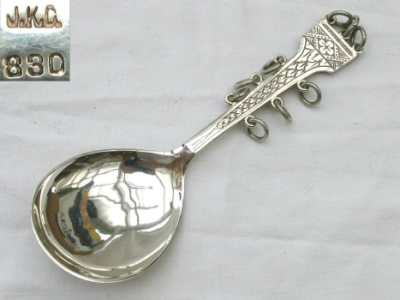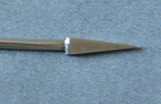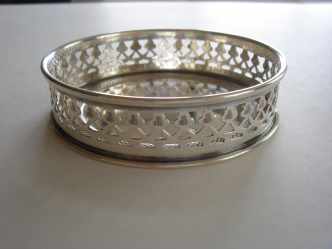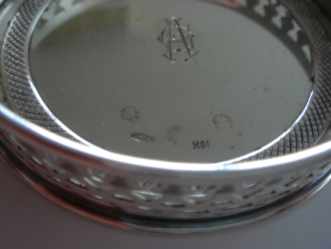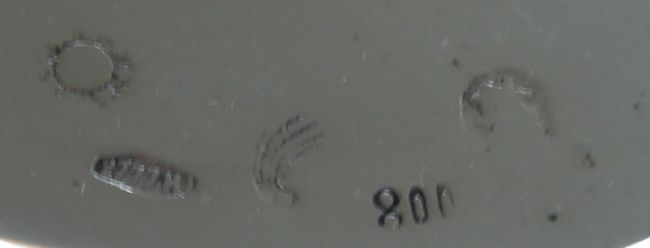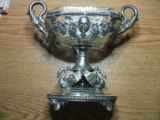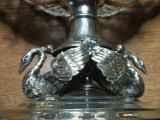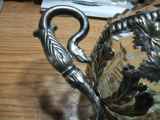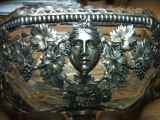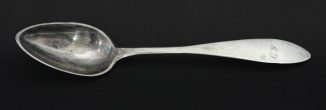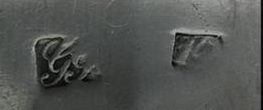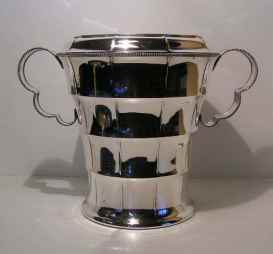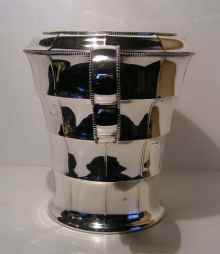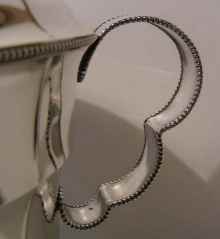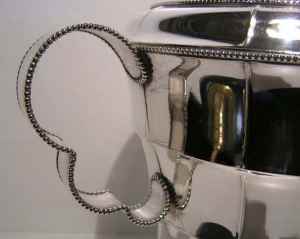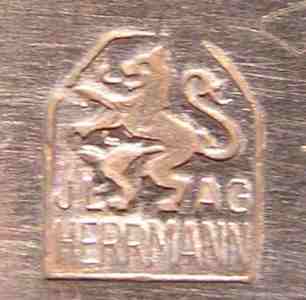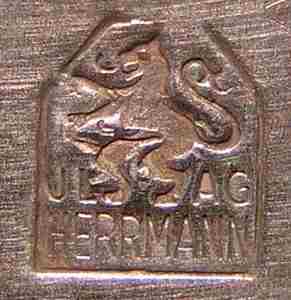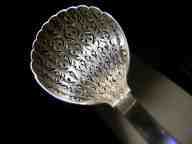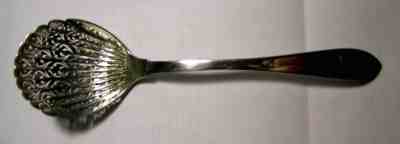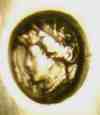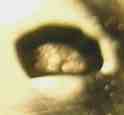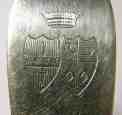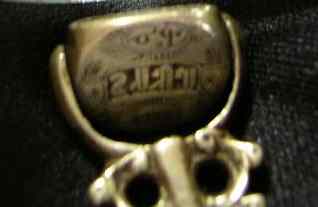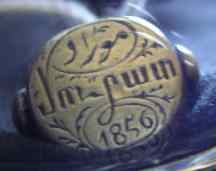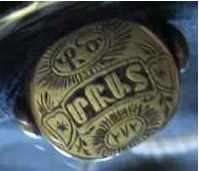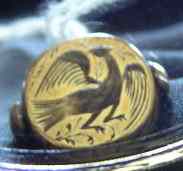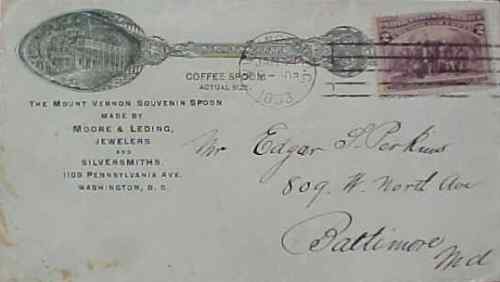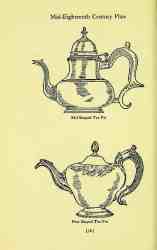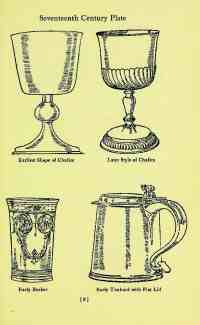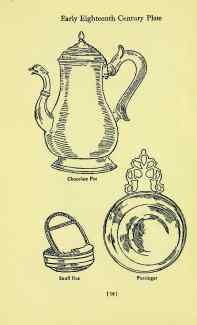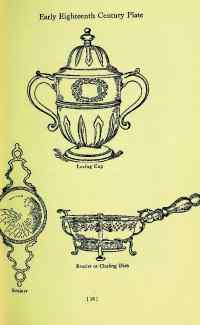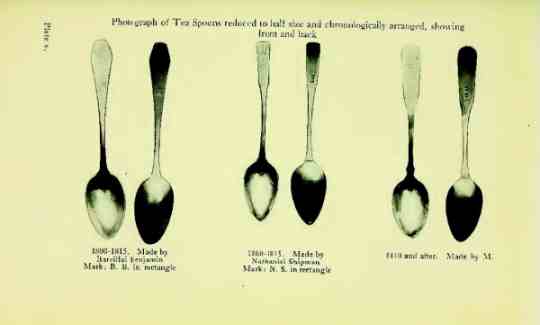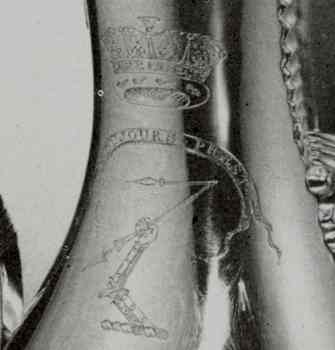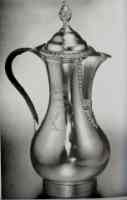 newsletter # 64 SEPTEMBER 2009
newsletter # 64 SEPTEMBER 2009www.ASCASonline.org SITE MAP
email: silverassociation@yahoo.it
YOUR GUIDE TO SEPTEMBER NEWSLETTER:
articles new members
members' window
|
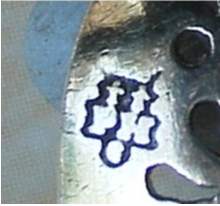
David McKinley presents: |
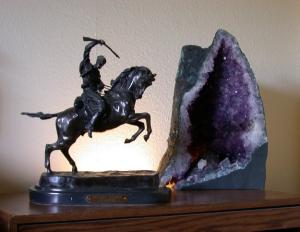
Lazar Freidgeim presents a lovely side of
American every day way of life scarcely known by most of
ASCAS members living outside the US: |
New members
Welcome to new ASCAS members:
Jeff Christensen - Australia
Natalie M. Dupre - USA
George Fitzgerald - England UK
Robin Holmes - South Africa
Ann Orcutt - USA
Frank Zahra - Malta
Oskar M. Zurell - Portugal
|
top page -
page map |
Members' Window # 64
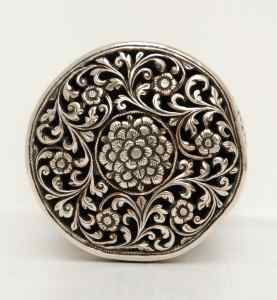
Michael Thomas presents:
|
Mail to ASCAS: e-mail silverassociation@yahoo.it
John J. Yale writes:
...Giorgio
I've never seen one like this before...have you?
9 rings hanging from the sides 155mm long and weighs 38.7 grams
John Yale
I believe that your spoon is a modern reproduction in the
style of 17th and 18th century spoons made for Lapp Market in
Trondheim and Bergen (Norway). Spoons with similar rings are
illustrated in a
catalog of Baltic and Scandinavian Silver of the V&A Museum
Giorgio Busetto
Peter Barnes writes:
I read with interest in the May newsletter David McKinley's very
informative
article on mote spoons. In it he remarks on the pronounced
spike terminal on a spoon he examined.
I thought it might be of interest that I have a similar spike on
a mote spoon from the shop of Paul De Lamerie.
Also of interest is that although he was a warden of the guild
he was notorious for avoiding the assay office, thus only his
1739 makers mark appears on this piece.
I am attaching a picture of the spoon and the spike terminal.
Peter Barnes
Dorothea Burstyn writes:
...Giorgio
maybe you can help me with the age of this coaster, only 8.2 cm
in diameter. Marks as attached, the mark 2777K or 2777H in
lozenge. It has a kind of "Edwardian" monogram, but is the item
a bit older. Where such small coaster used for wine bottles (a
bottle fits) or rather for glasses.
I appreciate your help.
Best,
Dorothea
Your coaster bears Italian official marks used between
1950/1970 c.
The mark (not well punched) '277 MI' and '800' belonged to Ditta
Soldati di Dabbene Marco, Via Solferino 23, Milano (Milan).
The coaster has also what appear to be ancient Lombardo Veneto
hallmarks (see my website at
http://www.silvercollection.it/LOMBARDOVENETOHALLMARKS.html
(the third mark is unclear).
The use of "ancient marks" in addition to official contemporary
marks (800 + lozenge) was a practice that had some diffusion in
the 1950s between silver makers of the Lombardo-Veneto territory
(Venice and Milan). I don't believe the objective of the maker
was to deceive the buyer (usually the silver was correctly
marked with modern marks and the item was sold through a
jeweller and not by an antique dealer).
Obviously I can't exclude that in some case (especially in the
late 20th century and outside of Italy) the seller acted to
deceive the incautious buyer (possibly rubbing out the modern
marks).
Giorgio Busetto
Gerald Gerhart writes:
...I am hoping that you or the membership may be able to assist
me in determining its origin.
The hallmarks are partially obliterated due to polishing, and I
have been unable to find out anything about them. I have
attached some close-ups, including one in grey-scale which I
hope will be of some help. The dish is constructed of
light-gauge silver and what is definitely crystal. My best guess
is that it may be a Hanau reproduction of a much earlier piece,
but that is just that - a guess.
I would be very grateful if you or the membership can provide me
with any other information.
Thanking you, in advance, I remain...
Yours truly
Gerald Gerhart
Eddie Robinson writes:
G/day Giorgio,
Would you know the age of this spoon and is it silver or Plate?
The attached picture is identical to the one I have - the only
difference is: Where the Letter [L] is in the picture - my spoon
has a number [2 in a shield] and on the right of the [S] there
are the words [guaranteed 11]
I believe it is Deykin & Sons Birmingham England.
Any help would be appreciated.
Best regards.
Eddie from down under
The maker is Joseph Deakin & Sons, Sheffield (see my
website at
http://www.silvercollection.it/electroplatesilverD.html).
Obviously your item is silver plate and not sterling or solid
silver.
The only further information I have is that this mark was used
1855-1891 and was seen in cutlery items.
Giorgio Busetto
Todd O'Malley writes:
...I submit three pictures to ask for some assistance in
identifying the hallmarks on my tablespoon.
I am not sure if it is American or Continental...
Your help is great appreciated.
Todd O'Malley
Possibly it's a spoon of "German Area" and the mark on
the right is a "12" indicating silver fineness in "lot"
Any suggestion will be welcome
Giorgio Busetto
Jeff Christensen writes:
....I am a collector of Art Nouveau, Art Deco and Arts & Craft
movements and have a fondness for the Secession style. I have a
champagne bucket I purchased at a local auction as the style had
elements of work I have seen by Prof. Otto Prutscher and Josef
Hoffman of the Wiener Werkstaette, but the mark was unknown to
me. I found Prof. Nikogosyan's article on Herrmann while trying
to research the mark and thought you might like a photograph of
the piece as the mark is slightly different from the examples in
your article.
I am also interested in finding any information on who may have
designed this piece. If you have any thoughts or suggestions
they would be greatly appreciated.
Kind regards,
Jeff Christensen
Unfortunately this mark is unknown to Prof. Nikogosyan. I
trust in members help.
Giorgio Busetto
Alessandro Colemann writes:
....I need your help in identifying the maker of this French
sugar sifter.
Any suggestion will be highly appreciated.
Alessandro Colemann
Replies to questions
Wayne Robbins receives these replies about his "Russian"
seal
(see June 2009 Newsletter)
Geldolph Everts writes:
...I have now consulted some friends about Wayne Robbins'
question in the June newsletter.
Here is their combined wisdom. Some of it confirms replies by
others.
The ring is Armenian and belonged to an Armenian person residing
in an Arab country. The first side (with the date 1856) shows a
name in Armenian lower case letters, reading Mrad (or Mrat),
which would be the name Murad(t) when written in Armenian. The
Arabic above it seems to read MWRAW (but this combination of
letters has no known meaning) and it could also be Murad(t). As
already mentioned by others, the name Murad(t) was sometimes
used by diaspora Armenians integrated in majority Arabic
communities. The name is not likely to be used nowadays by
Armenians.
The second side (the photo in the Newsletter was shown upside
down) has two Armenian letters (in lower case) at the top: (phonetically)
"kÚ" and "tsÚ". The middle name is in upper case and also reads
MRAD. At the bottom is the Arabic numeral 272.
The third side shows a griffin, the mythological bird (representing
Christ), central to Armenian religion, art and mythology. One
finds it i.e. in illuminated manuscripts and on Armenian
churches. I do not believe this ring is a seal as the letters
lose their meaning when pressed in wax.
Once more, best regards,
Geldolph Everts
After Dov Wulich article in July 2009 Newsletter, ASCAS received these new comments about the Russian mark illustrated in Fred Sinfield's Members' Window #44
Prof. David Nikogosyan writes:
The mark in Cyrillic is perfectly right.. It simply turned on
180 degrees.
 (sounds KHLEBNIKOV, the last Russian letter means "hard sign" or
hard pronouncing at the end of the Russian word, a family name
originating from word
(sounds KHLEBNIKOV, the last Russian letter means "hard sign" or
hard pronouncing at the end of the Russian word, a family name
originating from word
 ,
which means bread in English translation).
,
which means bread in English translation).
Simply, before the putting of Khlebnikov mark somebody rotated
this item for 180 degrees in the plane of image. Then you got
this Khlebnikov mark "up side down" relative to the "kokoshnik
mark.
Best regards,
David Nikogosyan
Lazar Freidgeim writes:
Marking "Hlebnikov" top seem to me of correct and
corresponding to a brand company. Until 1917 in Russia in the
alphabet, along with the letter "E", in some cases, used the
letter, called "Yat'" - like "Ib" together (the third letter in
the word), and at the end of words which are coming to an end on
a consonant, put an additional letter "a hard sign" (as "b" with
a hyphen above) was put in addition (the last letter in the
word).
Lazar Freidgeim
"A PAGE per MONTH"
In this column we present a page
obtained from makers' brochures, books, auction catalogs,
advertising or whatever other printed paper, related to silver,
that may be of interest for ASCAS members.
The images will be published at a "low resolution" level and for
private and personal use only
"A WORD per MONTH"
In this column we present an abstract
from a page of the "What is? Silver Dictionary"
courtesy of
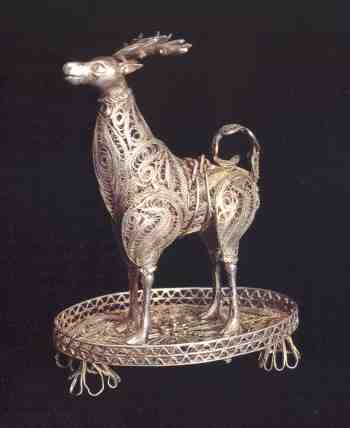
|
FILIGREE
|
"A SILVERSMITH per MONTH"
In this column we present marks,
information and history of silversmiths and silver manufacturers.
This column is published under the kind permission of Giorgio
Busetto's website
|
|
WAKELY & WHEELERA London silversmith firm whose origins go back to
1791, when John Lias began in business as a buckle-maker.
|
"A BOOK ON MY SHELF"
In this column we present books, new
or ancient, dealing with silver in all its aspects (history,
marks, oddities...). This isn't a "book review" but only a fair
presentation of some useful "tools" that anyone may have in the
shelf of his bookcase.
ASCAS members are invited to contribute to this column
(click to enlarge images)
The "book on my shelf" of this month presents:
EARLY SILVER OF CONNECTICUT
AND ITS MAKERS
by George Munson Curtis
International Silver Co
Meriden, Conn. 1913
AND ITS MAKERS
by George Munson Curtis
International Silver Co
Meriden, Conn. 1913
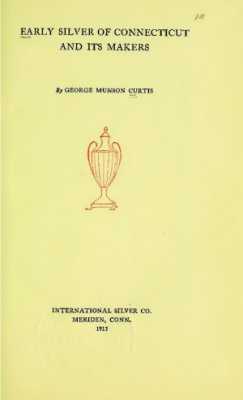 |
To those who are lovers of old
plate, and have familiar with the various shapes and
design characteristics of Colonial days, it is
interesting to note the slow evolution and gradual
change in church and domestic silver from the simple and
yet beautiful vessels of the seventeenth century to the
more elaborate forms and greater variety of articles of
the eighteenth century, which the growing luxury....
|
"A CREST per MONTH"
In this column we present images and description of Crests and Mottoes of British, Irish and Scottish Families as engraved in silver items.
Closing our SEPTEMBER 2009 edition of ASCAS Newsletter I hope you have appreciated its content.
Your comments, suggestions and advice will be of great help.
My thanks to Peter Barnes, Dorothea Burstyn, Jeff Christensen, Alessandro Colemann, Jayne Dye, Geldolph Everts, Lazar Freidgeim, Gerald Gerhart, David McKinley, David N. Nikogosyan, Todd O'Malley, Eddie Robinson, Michael Thomas, John J. Yale for their invaluable contributions.
Giorgio Busetto
Secretary
ASCAS is a community of people having a common
interest in antique silver.
|

